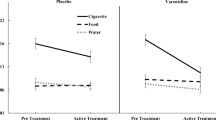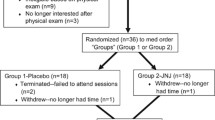Abstract
Rationale
Varenicline is an α4β2 nicotinic acetylcholine receptor partial agonist that has been found to be effective for treating tobacco dependence. However, the subjective and behavioral mediators of its efficacy are not known.
Objectives
Using multiple sessions of laboratory-based assessment, this double-blind, placebo-controlled experiment was designed to test if varenicline reduced both tonic and cue-provoked tobacco cravings, and if it attenuated perceived reward from smoking.
Methods
Participants in the present analysis include 100 smokers who were scheduled for three assessment sessions: at baseline, before receiving medication; at mid-run-in, 5–7 days after beginning medication; and after full dosage was reached, 12–15 days. Following overnight abstinence, each session included assessment of tonic craving, reactivity (including craving) to smoking cues, expected value of a cigarette, smoking behavior, and self-reported reward following smoking.
Results
Varenicline, compared to placebo, reduced tonic craving, cue-provoked craving by the final assessment, the expected value of cigarettes, number of puffs and time spent smoking, and self-reported reward (i.e., satisfaction) from smoking.
Conclusions
Results showing that varenicline reduced tonic craving levels and perceived reward from smoking are consistent with reports from clinical trials, strengthening the evidence in support of these subjective mechanisms of action. This is the first placebo-controlled study to demonstrate that varenicline reduced cue-provoked cravings, thereby offering another potential mediator of its therapeutic effects. Findings may aid in the development of more targeted interventions for tobacco dependence.

Similar content being viewed by others
References
Baker TB, Brandon TH, Chassin L (2004) Motivational influences on cigarette smoking. Ann Rev Psychol 55:463–491
Biener L, Abrams DB (1991) The Contemplation Ladder: validation of a measure of readiness to consider smoking cessation. Health Psychol 10:360–365
Blank MD, Disharoon S, Eissenberg T (2009) Comparison of methods for measurement of smoking behavior: mouthpiece-based computerized devices versus direct observation. Nicotine Tob Res 11:896–903
Brandon TH, Tiffany ST, Obremski KM, Baker TB (1990) Postcessation cigarette use: the process of relapse. Addict Behav 15:105–114
Brandon TH, Vidrine JI, Litvin EB (2007) Relapse and relapse prevention. Ann Rev Clin Psychol 3:257–284
Brody AL, Mandelkern MA, London ED, Childress AR, Lee GS, Bota RG et al (2002) Brain metabolic changes during cigarette craving. Arch Gen Psychiatry 59:1162–1172
Cappelleri JC, Bushmakin AG, Baker CL, Merikle E, Olufade AO, Gilbert DG (2007) Confirmatory factor analysis and reliability of the modified cigarette evaluation questionnaire. Addict Behav 32:912–923
Carter BL, Tiffany ST (1999) Meta-analysis of cue reactivity in addiction research. Addiction 94:327–340
Carter BL, Robinson JD, Lam CY et al (2006) A psychometric evaluation of cigarette stimuli used in a cue reactivity study. Nicotine Tob Res 8:361–369
Center for the Study of Emotion and Attention (1995) The International Affective Picture System [photographic slides]. The Center for Research in Psychophysiology, University of Florida, Gainesville
Darredeau C, Barrett SP (2010) The role of nicotine content information in smokers' subjective responses to nicotine and placebo inhalers. Hum Psychopharmacol 25:577–581
Drobes DJ (2002) Cue reactivity in alcohol and tobacco dependence. Alcohol Clin Exp Res 26:1928–1929
Ferguson SG, Shiffman S (2009) The relevance and treatment of cue-induced cravings in tobacco dependence. J Subst Abuse Treat 36:235–243
First MB, Spitzer RL, Gibbon M, Williams JBW (1996) Structured Clinical Interview for DSM-IV Axis I Disorders, Clinician Version (SCID-CV). American Psychiatric Press, Inc., Washington
Fisher S, Greenberg RP (1993) How sound is the double-blind design for evaluating psychotropic drugs? J Nerv Ment Dis 181:345–350
Franklin T, Wang Z, Suh JJ et al (2011) Effects of varenicline on smoking cue-triggered neural and craving responses. Arch Gen Psychiatry 68:516–526
Fucito LM, Juliano LM (2007) Effects of instructions on responses to the nicotine patch: a laboratory study. Psychopharmacol 194:475–483
Gilbert DG, Rabinovich NE (2003) International smoking images series (with neutral counterparts, version 1.2).Integrative Neuroscience Laboratory, Department of Psychology, Southern Illinois University, Carbondale
Gonzales D, Rennard SI, Nides M et al (2006) Varenicline, an α4β2 nicotinic acetylcholine receptor partial agonist, vs sustained-release bupropion and placebo for smoking cessation: a randomized controlled trial. JAMA 296:47–55
Griffiths RR, Troisi JR, Silverman K, Mumford GK (1993) Multiple-choice procedure: an efficient approach for investigating drug reinforcement in humans. Behav Pharmacol 4:3–13
Harris AC, Pentel PR, Lesage MG (2007) Prevalence, magnitude, and correlates of an extinction burst in drug-seeking behavior in rats trained to self-administer nicotine during unlimited access (23 h/day) sessions. Psychopharmacology 194:395–402
Heatherton TF, Kozlowski LT, Frecker RC, Fagerström KO (1991) The Fagerström test for nicotine dependence: a revision of the Fagerström Tolerance Questionnaire. Br J Addict 86:1119–1127
Hendricks PS, Ditre JW, Drobes DJ, Brandon TH (2006) The early time course of smoking withdrawal effects. Psychopharmacology 187:385–395
Jorenby DE, Hays JT, Rigotti NA et al (2006) Efficacy of varenicline, an α4β2 nicotinic acetylcholine receptor partial agonist, vs placebo or sustained-release bupropion for smoking cessation: a randomized controlled trial. JAMA 296:56–63
Kidorf M, Stitzer ML, Griffiths RR (1995) Evaluating the reinforcement value of clinic-based privileges through a multiple choice procedure. Drug Alcohol Depend 39:167–172
Litvin EB, Brandon TH (2010) Testing the influence of external and internal cues on smoking motivation using a community sample. Exp Clin Psychopharmacol 18:61–70
Niaura R, Abrams D, Demuth B, Pinto R (1989) Responses to smoking-related stimuli and early relapse to smoking. Addict Behav 14:419–428
Nides M, Oncken C, Gonzales D et al (2006) Smoking cessation with varenicline, a selective α4β2 nicotinic receptor partial agonist. Arch Intern Med 166:1561–1568
O'Connor EC, Parker D, Rollema H, Mead AN (2010) The alpha4beta2 nicotinic acetylcholine-receptor partial agonist varenicline inhibits both nicotine self-administration following repeated dosing and reinstatement of nicotine seeking in rats. Psychopharmacol 208:365–376
Oncken C, Gonzales D, Nides M et al (2006) Efficacy and safety of the novel selective nicotinic acetylcholine receptor partial agonist, varenicline, for smoking cessation. Arch Intern Med 166:1571–1577
Patterson F, Jepson C, Strasser AA et al (2009) Varenicline improves mood and cognition during smoking abstinence. Biol Psychiatry 65:144–149
Perkins KA (2009) Does smoking cue-induced craving tell us anything important about nicotine dependence? Addiction 104:1610–1616
Perkins KA, Doyle T, Ciccocioppo M, Conklin C, Sayette M, Caggiula A (2006) Sex differences in the influence of nicotine dose instructions on the reinforcing and self-reported rewarding effects of smoking. Psychopharmacology 184:600–607
Perkins KA, Lerman C, Fonte CA et al (2010a) Cross-validation of a new procedure for early screening of smoking cessation medications in humans. Clin Pharmacol Ther 88:109–114
Perkins KA, Mercincavage M, Fonte CA, Lerman C (2010b) Varenicline's effects on acute smoking behavior and reward and their association with subsequent abstinence. Psychopharmacology 210:45–51
Reid MS, Palamar J, Raghavan S, Flammino F (2007) Effects of topiramate on cue-induced cigarette craving and the response to a smoked cigarette in briefly abstinent smokers. Psychopharmacology 192:147–158
Rose JE, Behm FM, Westman EC (1998) Nicotine-mecamylamine treatment for smoking cessation: the role of pre-cessation therapy. Exp Clin Psychopharmacol 6:331–343
Rose JE, Behm FM, Westman EC, Johnson M (2000) Dissociating nicotine and nonnicotine components of cigarette smoking. Pharmacol Biochem Behav 67:71–81
Rose JE, Behm FM, Westman EC (2001) Acute effects of nicotine and mecamylamine on tobacco withdrawal symptoms, cigarette reward and ad lib smoking. Pharmacol Biochem Behav 68:187–197
Shiffman S (1982) Relapse following smoking cessation: a situational analysis. J Consult Clin Psychol 50:71–86
Shiffman S, Paty JA, Gnys M, Kassel JA, Hickcox M (1996) First lapses to smoking: within-subjects analysis of real-time reports. J Consult Clin Psychol 64:366–379
Shiffman S, Shadel WG, Niaura R et al (2003) Efficacy of acute administration of nicotine gum in relief of cue-provoked cigarette craving. Psychopharmacology 166:343–350
Shiffman S, Gwaltney CJ, Balabanis MH et al (2004) Immediate antecedents of cigarette smoking: an analysis from ecological momentary assessment. J Abnorm Psychol 111:531–545
Tiffany ST, Drobes DJ (1991) The development and initial validation of a questionnaire on smoking urges. Br J Addict 86:1467–1476
Tiffany ST, Cox LS, Elash CA (2000) Effects of transdermal nicotine patches on abstinence-induced and cue-elicited craving in cigarette smokers. J Consult Clin Psychol 68:233–240
Tonstad S, Tonnesen P, Hajek P, Williams KE, Billing CB, Reeves KR (2006) Effect of maintenance therapy with varenicline on smoking cessation. JAMA 296:64–71
Waters AJ, Shiffman S, Sayette MA, Paty JA, Gwaltney CJ, Balabanis MH (2004) Cue-provoked craving and nicotine replacement therapy in smoking cessation. J Consult Clin Psychol 72:1136–1143
Welsch SK, Smith SS, Wetter DW, Jorenby DE, Fiore MC, Baker TB (1999) Development and validation of the Wisconsin Smoking Withdrawal Scale. Exp Clin Psychopharmacol 7:354–361
West R, Baker CL, Cappelleri JC, Bushmakin AG (2008) Effect of varenicline and bupropion SR on craving, nicotine withdrawal symptoms, and rewarding effects of smoking during a quit attempt. Psychopharmacology 197:371–377
Westman EC, Levin ED, Rose JE (1992) Smoking while wearing the nicotine patch: is smoking satisfying or harmful? (Abstract). Clin Res 40:871A
Wouda JA, Riga D, De Vries W et al (2011) Varenicline attenuates cue-induced relapse to alcohol, but not nicotine seeking, while reducing inhibitory response control. Psychopharmacology. doi:10.1007/s00213-011-2213-8
Acknowledgements
This study was funded by Pfizer, Inc. via Investigator Initiated Research Grant #GA3051LP. The authors thank Kristen M. Sismilich, Monica S. Carrington, and Brittany Weisenthal for their work on the project.
Conflicts of interest
Dr. Brandon has served on the Varenicline Advisory Board for Pfizer and consulted on the development of the online behavioral adjuvant for varenicline users.
Author information
Authors and Affiliations
Corresponding author
Rights and permissions
About this article
Cite this article
Brandon, T.H., Drobes, D.J., Unrod, M. et al. Varenicline effects on craving, cue reactivity, and smoking reward. Psychopharmacology 218, 391–403 (2011). https://doi.org/10.1007/s00213-011-2327-z
Received:
Accepted:
Published:
Issue Date:
DOI: https://doi.org/10.1007/s00213-011-2327-z




